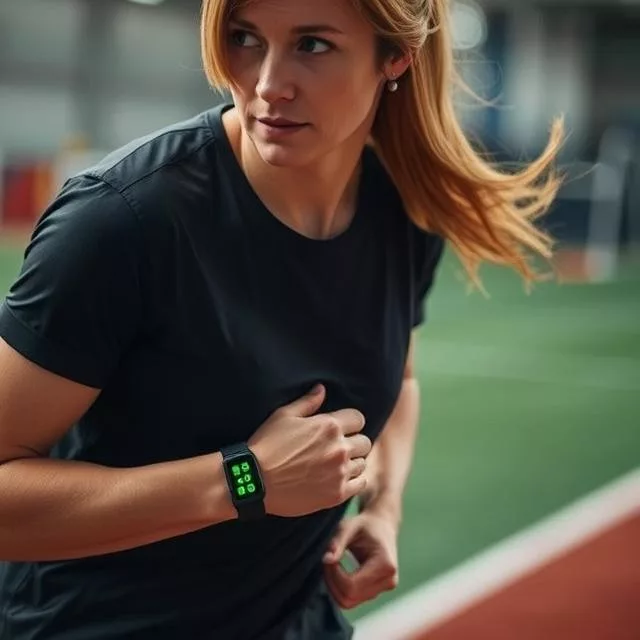
Wearable technology in sports has become common place over the years. Sport technology has improved in leaps and bounds, delivering beginners and seasoned athletes easy to use data analysis. Which
Wearable Technology in Sports
The Game-Changing Gear Revolutionizing Performance
Wearable technology in sports isn’t just a trend anymore, it’s a vital part of athletic performance. Today, athletes from amateurs to professionals rely on these innovative tools to gain real-time insights into their training, recovery, and overall health. From fitness watches to smart clothing, these devices are transforming how sports are played, trained for, and understood.
We’re no longer just talking about step counters. Modern wearables offer advanced features like heart rate monitoring, GPS tracking, oxygen saturation sensors, and even stress detection. They’re essentially compact health assistants, personal trainers, and sports scientists wrapped into one.

How Wearable Technology in Sports is Enhancing Training and Recovery
Wearables allow athletes to monitor key performance indicators with pinpoint accuracy. Data from these devices help personalize training plans, ensuring athletes train smarter, not just harder. By analysing trends over time, wearables help identify weak points, manage fatigue, and optimize performance without crossing into overtraining territory.
For example:
- Heart rate variability (HRV) gives insight into an athlete’s recovery status.
- Sleep trackers ensure rest and regeneration are prioritized.
- Hydration sensors and muscle fatigue monitors help prevent injuries by alerting users before issues arise.
Fitness Watches – Your Portable Performance Lab
Take fitness watches, for example. Brands like Garmin, Apple, and Polar are at the forefront, offering devices packed with AI-powered insights and athlete-specific metrics.
- Garmin appeals to endurance athletes, offering VO2 max, lactate threshold, and real-time pace guidance.
- Apple Watch Ultra provides in-depth health monitoring alongside ECG and fall detection, useful for training and general wellness.
- Polar is renowned for precision heart rate monitoring, making it a favourite for elite runners and cyclists.
These smartwatches sync with powerful apps that visualize data trends and generate personalized coaching advice. Athletes can now plan and adapt workouts based on science-backed performance data, not just intuition.
Smart Clothing: The Next Generation of Wearable Tech
While fitness watches dominate the consumer space, smart clothing is quietly disrupting elite training environments. Embedded with sensors in shirts, shorts, and even socks, smart textiles monitor:
- Muscle engagement and symmetry
- Joint movement
- Core body temperature
- Hydration levels
Brands like Hexoskin and Athos offer biometric garments that stream data live to coaches and athletes, facilitating instant feedback during drills or competition. This technology enhances injury prevention by detecting imbalances or overuse before symptoms surface.

Pioneering Innovations Shaping the Future of Wearable Technology in Sports
The future of wearable technology in sports looks even more promising. As AI and machine learning become increasingly integrated, wearables will evolve from passive monitors to intelligent coaching companions.
Imagine a smart shoe that:
- Learns your running gait
- Adjusts support in real-time
- Provides vibration feedback to correct posture
Designers are also prioritizing flexibility and comfort, making these devices barely noticeable during play. Meanwhile, sustainability is becoming a core principle, biodegradable sensors and eco-friendly manufacturing methods are now part of the development roadmap.
Leading Wearable Technology in Sports Brands – A Comparison Guide
When choosing a wearable, consider what best suits your sport and personal needs. Here’s a quick comparison:
Brand Strengths Ideal For
Garmin Advanced training metrics, GPS precision Runners, triathletes, cyclists. Fitbit User-friendly wellness tracking General fitness users. Polar Accurate HR tracking, sleep analysis Endurance athletes. Whoop Recovery and strain monitoring High-performance optimization. Apple All-in-one health and lifestyle Versatile training & health.
These tools are being used not only by casual athletes but also by Olympians, football teams, and endurance racers who depend on actionable data for incremental improvements that lead to major wins.
Real-World Success Stories: Athletes and Teams Using Wearables
Professional sports teams and individual athletes now rely on wearables as part of their day-to-day routines. For instance:
- NFL and rugby teams use GPS vests to track sprint distances and explosive movements.
- Marathon runners track lactate threshold trends and tapering strategies.
- Tennis players monitor joint impact to avoid repetitive strain injuries.
By combining different devices, smart clothing, watches, and recovery tools—athletes develop a 360-degree view of their performance.

Final Thoughts – Is Wearable Technology in Sports Worth It?
Whether you’re an elite competitor or a weekend warrior, the benefits of integrating wearable technology in sports are clear:
- Improved training efficiency
- Reduced risk of injury
- Better recovery
- Data-driven decision making
It’s not just about keeping up with trends, it’s about future-proofing your athletic journey. The smarter your gear, the more intelligent your performance becomes.
FAQs About Wearable Technology in Sports
Q: Are wearable devices accurate enough for professional use?
A: Top-tier devices like those from Garmin, Polar, and Whoop offer lab-tested accuracy, trusted by sports professionals globally.
Q: What sports benefit most from wearables?
A: Almost all! But endurance sports (running, cycling), team sports (football, basketball), and high-impact disciplines (tennis, CrossFit) gain the most immediate insights.
Q: How do wearables help prevent injuries?
A: By tracking fatigue, muscle usage, hydration, and stress markers, wearables can alert athletes before minor issues become serious injuries.
Grab your wearable technology in sports today and let us know tomorrow, leave your comment below.
Ultimate Training Gear






